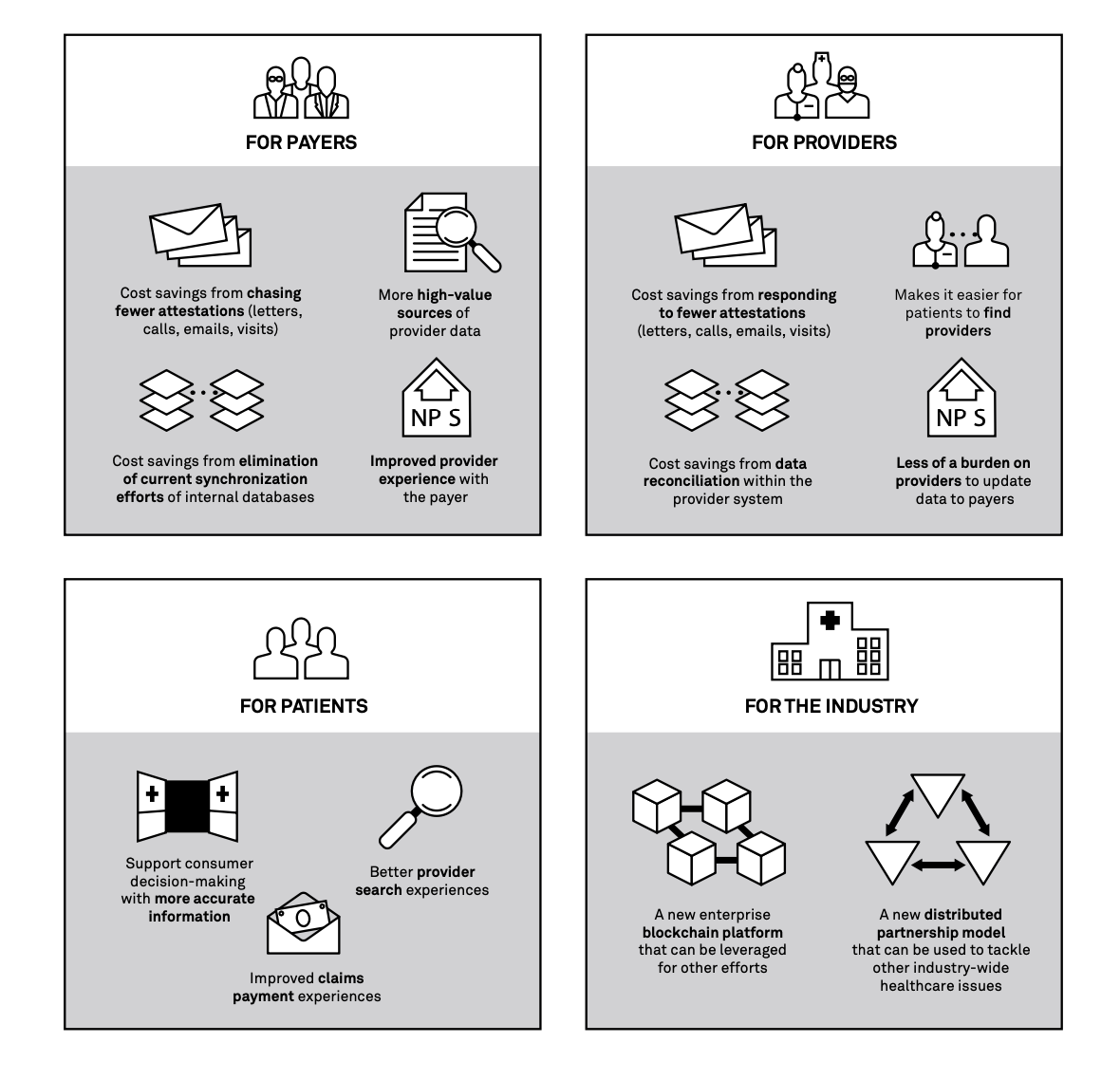Why the Alliance:
The Synaptic Health Alliance is a unique collaboration between industry-leading companies with various roles between vendor/client, provider/network, and competitors within the healthcare ecosystem. The alliance is committed to build a framework to solve widespread data management issues within the healthcare ecosystem through the use of blockchain technology.
The Problem
The Synaptic Health Alliance was formed by Humana, MultiPlan, Optum, Quest Diagnostics, and United Healthcare to explore the use of blockchain technology in improving the accuracy and efficiency of provider data management and sharing. Healthcare providers spend billions in cross-company data sharing and administration which could be disrupted and improved by integrating blockchain that enables built-in transparency and verifiability between the participating organizations.
Hospitals, doctors, and health insurers across the healthcare ecosystem spend roughly $2.1 billion dollars to maintain provider data. State and federal laws require health plans to regularly update their directories on a regular basis - monthly or even more repeatedly. This results in redundant manual administrative processes which create high maintenance costs and silos of data.
Why Accurate Data Matters
Major health plans participating in the Medicare Advantage program may face penalties of up to $25,000 per day per beneficiary or be forced out of new enrollment and marketing if their directories have high error rates. Having high error rates in provider directories causes major implications. Healthcare providers could be incorrectly listed as “out-of-network” and can prevent prospective or current patients. Most importantly, consumers rely on these directories to find doctors in their location that are accepting new clients, are in-network, close in proximity, and contact information when healthcare is needed.
In summary, consumers and doctors rely on healthcare providers as the “middle-man” to efficiently and accurately reconcile their databases to connect consumers to doctors, clinics, and hospitals that are in-network. If the reconciliation process lacks accuracy it costs doctors the possibility to acquire new business, puts the patient at risk of not finding the correct care, and financially penalizes the healthcare provider through penalties and fees.
Solution: Blockchain
The Synaptic Healthcare Alliance hopes to utilize blockchain to enable cross-platform data sharing and reconciliation through a distributed ledger. Using a distributed ledger to record provider data allows all participants to reconcile their data efficiently and accurately while eliminating redundant and costly administrative tasks. It also lowers the risk of penalization for data errors as their is a clear audit trail that all organizations and participants have access too.
By enabling blockchain as a shared ledger, the Alliance could further explore incentives for users to motivate data sharing with everyone in the blockchain network that would improve data quality, decrease maintenance costs, and eliminate data-silos across platforms. A business model that many enterprises and start-ups are exploring today through public and private blockchains.

Potential Future Use Cases:
The Synaptic Health Alliance used the private-permissioned Quorum blockchain which is designed to develop and evolve alongside Ethereum. There are many current benefits for enterprises to choose a permissioned blockchain as a platform to deploy these operations, however future decentralization could be considered for better future user experience.
How an Arbitrum Orbit Chain could be used:
An Arbitrum Orbit blockchain is a customizable blockchain developed by Offchain Labs. Some of the major characteristics of a customizable blockchain is the ability to make it as centralized or decentralized as the client desires. Want it fully decentralized? Done. Want it centralized between 6 entities (Similar to the Synaptic Health Alliance)? Done.
A few of the major benefits to using a Layer-2 with Data Availability Committee is that permissioned entities will have full control of the nodes and approve/deny transactions that are submitted to the Ethereum blockchain through a sequencer. The Layer-2 blockchain also benefits from the security model of the Ethereum parent chain.
In a pilot, a private permissioned blockchain makes sense as consumers (patients) are not necessarily live in the permissioned blockchain yet. This creates centralization and transparency gaps between the entities and the patients. By using a customizable Layer-2 it allows the entities to integrate progressive decentralization that will allow consumers access to the general ledger, and give the organizations involved the ability to add new entities in the future to make the network more robust.
Interoperability in a private blockchain is also a large hurdle to overcome in contrast to a Layer-2. By integrating a data availability layer like Celestia or interoperability layer like Layer Zero, it will give the consumer the ability to transfer their personal data across networks. This is important for the patient in case they decide to switch to a different healthcare provider using a different blockchain network.
Conclusion
Blockchains are still trying to find their product-market fit to enable that 0-1 moment. Currently, public blockchains hold a strong use case for decentralized and permissionless access to financial tools for personal financial gain. However, blockchains hold potential for enterprises to automate administrative tasks and create interoperability and access to valuable larger sums of data across current platforms.